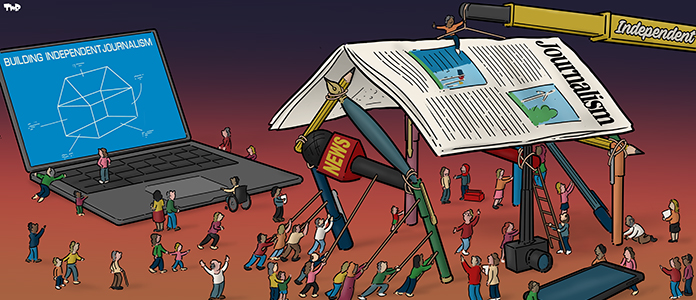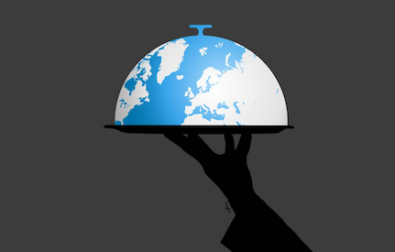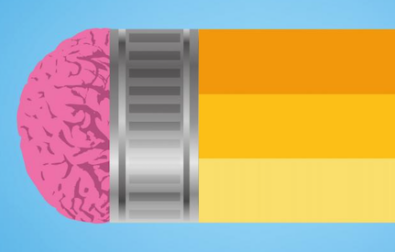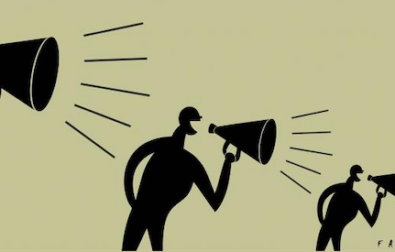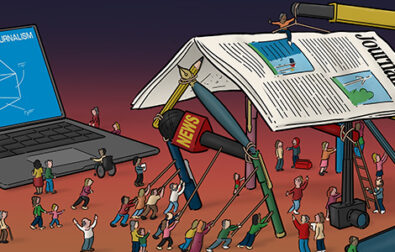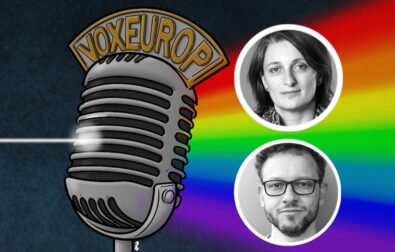The full story behind the painted monument to the Soviet army [see below] reveals what governs us. Not the politicians in power at the moment, but the mentality that leaves Bulgaria a country that resists change. And when something does finally happen, the monument is steam-cleaned at three in the morning. The anonymous painters did not just paint over the grey figures of the monument. They painted over the grey face of power itself.
Vezhdi Rashidov [Minister of Culture and a famous sculptor] described the make-over of Soviet soldiers into American pop culture heroes as “vandalism”. Evidently, for the Minister, art is reduced to a few pieces of bronze on display in the lobby of a company headquarters, or the paintings modestly hung in the offices of banks. Contemporary art ought to be like classical art, but turned out by living artists. A “spirituality”, secluded and sheltered in a safe or in an exhibition hall.
Yes, art perhaps has no value if the authors are anonymous. And most importantly, when they have not yet been paid for their work. They are even threatened with two years in prison if they are found out.
The public prosecutor seems to have already settled, once and for all, the problems of organised and disorganised crime, human trafficking and smuggling in the country. And so on his own initiative he has rushed to open “pre-trial proceedings against unknown perpetrators of vandalism.”
For the corporatist political caste of today, art is a commodity [...] And the worst of it is the provocations of those who challenge the received wisdom. In that case, it’s not art: it’s vandalism. Especially when it comes to memory and history.
Boyko Borisov as Don Corleone
The make-over of the bas-relief is an “assault on historical memory,” one hears. But historical memory is not something immutable, handed down once and for all, to be protected from the “vandals”. What a monument symbolises changes, and this symbol has been and will be up for discussion.
Monuments are an attempt to cloak clashing interpretations of history behind figures of bronze or granite. But it is impossible to escape the war over the past. Especially where the Soviet army and its monument are concerned. That's why arriving at its visual transformation is a logical step. What is surprising in this case is the intelligence and artistic subtlety of the work.
Painting a Soviet soldier as Batman is a sacrilege. It’s an “undermining of historical memory” when history is rewritten in a non-organised way, without the sanction of the party and state. And that is the case before us.
But a monument symbolises something other than the event it commemorates. It is a strong embodiment of the power that put it in place, and hundreds of years must pass before one can, symbolically, rub it away. Power, in all historical periods, has always been enamoured of symbols, uniforms, pomp and monuments. For they encourage submission.
The monuments are there constantly to remind us of who has the power to impose an “official” memory of the past. In fact, nowadays, that's what Boyko Borisov is doing in the media. Through his physical presence on television, the prime minister continually appoints himself as the authority. As a monument to himself. That's why cartoonists and comedians continue to “paint” him as Don Corleone, as a Communist leader, as Batman...
Art of the streets, not the boss’s office
Indeed, the reaction of leaders of the GERB [the ruling party] to this situation has been profoundly comical. Their reflexes lead them to identify themselves as “the State” and “history”, understood as monolithic and unquestionable values. At the same time, they realise that this is the sign of a communist regime.
Well, the monument eventually got cleaned up. “We are not in the Czech Republic, where the Russian tank that David Černý painted pink in 1991 is still pink, though only a replica [painted in April 1991, the tank celebrating the Red Army in a square in Prague is now on display at the Museum of Military Technology in Lešany]. Despite the clean-up, the monument will never be the same – the photos and memories will stay.
This repainted monument is one of those rare examples that show how one can approach the past not only full of reverence or denial, but also with a smile and some self-deprecation. This is modern art: art that plays with the context, that is produced in the streets, not in the solitude of showrooms or in the boss’s office.
The transformation of the sculpted heroes into comic strip figures has made everyone grasp that the “victors” in bronze form part of a culture for the masses that represents not the millions of dead soldiers, but the power of “triumphant socialism.”
“The anonymous authors” sought by the public prosecutor stand for the hope that our society is changing gradually. And the power? The power hasn’t changed.
Background
A colourful happening
On the morning of June 18 the citizens of Sofia woke to discover that during the night the soldiers on the monument to the Soviet Army, located in the centre of the city, had been repainted in the colours and capes of Batman, Superman, Santa Claus and other characters. Three days later, the monument was cleaned during the dead of night by the local authorities, with the patriotic association Forum Bulgaria-Russia Forum stumping up the money for the cash-strapped city council. The artists responsible are now being sought.
The monument to the Soviet army was erected in 1954 by the Bulgarian Communist Party to symbolise the gratitude of the Bulgarian people to their Red Army saviours, who liberated them from Nazism. Since 1993, after the fall of communism, there has been much debate on the role and significance of the monument. Other symbols of the USSR still remain in the large Bulgarian cities.
Do you like our work?
Help multilingual European journalism to thrive, without ads or paywalls. Your one-off or regular support will keep our newsroom independent. Thank you!






